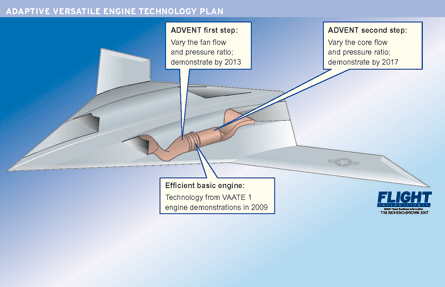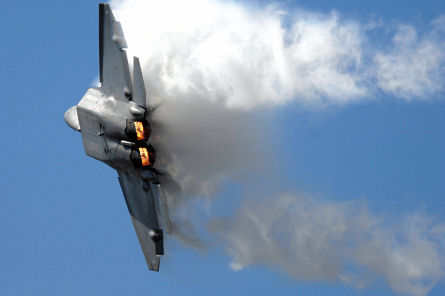Variable-cycle engines combining high performance and fuel efficiency are spearheading resurgent US research into advanced turbine technologies.
|
|---|
Technology demonstrated under VAATE could enhance the F-22's P&W F119 engines |
In the years immediately following the Second World War, jet propulsion wrought rapid changes in combat aircraft design. Jet engines promised to push aircraft beyond any speed possible with propeller power, but the early gas turbines were short on thrust and long on thirst.
In a bid to provide fighter escorts for its long-ranging but lumbering strategic bombers, the USA conceived the idea of combining jet propulsion for speed with propeller power for endurance. This produced a couple of unfortunate turbojet/prop hybrids, McDonnell's XF-88 and Republic's XF-84H - nicknamed the Thunderscreech after the vomit-inducing noise of its supersonic propeller.
Ultimately in-flight refuelling eliminated the need to combine two forms of propulsion in one airframe, and jet engine development began diverging towards afterburning power for supersonic fighters and fuel-sipping efficiency for subsonic transports. Now there is a move to reunite the requirements for high speed and long endurance in one engine for long-range, persistent strike and surveillance.
The ability to vary the cycle of a turbine engine between the low bypass ratio and high thrust required for supersonic dash and the high bypass and low fuel burn required for subsonic loiter is to be developed under the Adaptive Versatile Engine Technology (ADVENT) programme, with contracts to build ground demonstrators to be awarded by the US Air Force Research Laboratory (AFRL) by late July.
Multi-agency programme
ADVENT is part of the multi-agency Versatile Affordable Advanced Turbine Engines (VAATE) programme, the follow-on to AFRL's successful Integrated High Performance Turbine Engine Technology (IHPTET) programme, which ended earlier this decade having achieved its goal of doubling engine thrust-to-weight ratio. Technologies from IHPTET have found their way into engines powering Lockheed Martin's F-22 and F-35 fighters.
Like IHPTET, VAATE is a national programme that brings together US government-supported research into turbine engine technologies. Unlike IHPTET, which was focused on "flange-to-flange" engine performance, VAATE encompasses the entire propulsion system from inlet to exhaust and has a remit to develop multi-use technologies for a wide range of engine types, civil and military, with an emphasis on affordability.
Following the success of the tightly focused IHPTET programme, the wider-ranging VAATE initiative struggled to gain traction with the military, with the result that its first phase, culminating to demonstrator engine runs in 2009, is underfunded. This led to a revamping of the programme to emphasise capabilities, rather than technologies, and produced a series of "game-changing concepts", one of which is ADVENT.
"After the success of IHPTET, we faced an uphill battle bringing VAATE on board. People believed turbine technology had peaked and asked why we needed another multi-year programme," says AFRL's Larry Burns, VAATE programme manager. "It was a fierce battle to convince military planners to put research and development money into technology for next-generation turbine engines."
Investment plan
The key was a capability-based investment plan. "We could not get their support just selling technology, like IHPTET. We had to get the user community to identify with VAATE," says Burn. "Two and a half years ago we underwent a transformation to capability-based planning. We got direction from the Department of Defense on areas where we needed to invest in turbine engine technology and ADVENT was one area that came out."
ADVENT is the flagship of VAATE's second phase, which will culminate in demonstrator-engine ground runs by 2013. Although it is a VAATE 2 project, contract award has been brought forward, says Burns, because the capability-based approach has resulted in a substantial increase in funding for the programme. Two other programmes have been brought forward: the Advanced Affordable Turbine Engine (AATE) and Highly Efficient Embedded Turbine Engine (HEETE).
Under VAATE, six engine companies - General Electric, Honeywell, Pratt & Whitney, Rolls-Royce, Williams International and Teledyne Continental Motors - are working on a series of demonstrators ranging from small expendable turbojets, through rotorcraft turboshafts to large turbofans. Three airframers are also involved: Boeing, Lockheed Martin and Northrop Grumman.
VAATE 1 projects include the High-Speed Turbine Engine Demonstration (HiSTED), under which Rolls-Royce's Liberty Works and Williams are developing Mach 4+ expendable turbojets for missiles. Teledyne is working on a subsonic missile engine under the Efficient Small Scale Propulsion (ESSP) demonstration. While HiSTED is focused on high speed, ESSP emphasises fuel efficiency and low cost, says Burns.
Honeywell is working on the Small Heavy Fuel Engine (SHFE), a US Army-led project to demonstrate large reductions in fuel consumption and cost in a 700shp (520kW)-class turboshaft aimed at rotorcraft and unmanned air vehicles. The army's Aviation Applied Technology Directorate is now evaluating bids for AATE, which is to demonstrate a 3,000shp-class turboshaft with 25% better specific fuel consumption (sfc), 80% higher power-to-weight ratio and 35% lower production and maintenance costs.
In the large-engine arena, GE and P&W are working on two turbofan demonstrators under VAATE 1. Because of funding constraints, Burns says, these demonstrators are based on engines under development to power the F-35 Joint Strike Fighter: P&W's F135 and GE's F136. The demonstrations will mature technologies for insertion in the JSF engines and will be the point of departure for ADVENT.
P&W's demonstrator, the XTE68/LF1, will test next-generation hot section technologies for transition to the F135, says Bennett Croswell, vice-president, military development programmes. These include advanced turbine aerofoil materials and thermal barrier coatings, as well as prognostic health management technologies. "In 2009, we will demonstrate a complete engine with increased turbine temperatures and increased power, providing thrust growth for the F135," he says.
P&W is working on two other demonstrators under VAATE 1. One is the Compact Efficient Direct Lift Engine (CEDLE). "We will not reach a full-up demonstration within VAATE 1 because there isn't sufficient funding," says Burns. "Instead we will attack the technology challenges for a future demonstrator."
The second demonstrator comes under HEETE, which has different definitions in VAATE 1 and 2, says Burns. Under VAATE 1, Honeywell and P&W are demonstrating small turbofans aimed at powering unmanned combat air vehicles. The goal is to improve fuel efficiency to extend the range and loiter capabilities of UCAVs.
P&W expects to run its XTE67/A1 demonstrator early next year. "The focus is on systems integration technology and how to affordably deliver advanced technology," says Croswell. The engine is based on an advanced commercially derived core - high-pressure compressor, combustor and turbine - combined with an advanced fan. Technologies to be incorporated include an integrated starter/generator producing electrical power from the core.
For VAATE 2, HEETE takes on a different character. "It will focus on addressing technology barriers associated with the base cycle of the turbofan engine," says Burns. "There is a limit to how high the overall pressure ratio can go before the compressor exit temperature gets too hot. There is a barrier that needs to be broken through.
"The key to a breakthrough in sfc reduction is the fundamental engine cycle," says Burns. "A big part is the compressor, which we plan to push to higher pressure ratios and exit temperatures than anything accomplished in the past." Challenges will involve materials, structures and cooling, as the compressor air will be too hot to cool the turbine. "We will have to incorporate thermal management to deal with hotter air," he says.
According to AFRL's April call for proposals, the primary objective of HEETE is to achieve a 25% sfc reduction for an embedded 20,000-35,000lb thrust engine. Compared to a baseline engine, the goal is to demonstrate by 2014 increases of 2.3 times in overall pressure ratio and 163ºC (325ºF) in compressor exit temperature at maximum thrust on a hot day. Technologies identified include advanced high-efficiency aerodynamics high-pressure, low-leakage air seals combined with clearance control devices active flow control features and compact, lightweight heat exchangers to cool the cooling air.
Fresh attention
Programmes like HEETE are bringing new attention to VAATE, but it is ADVENT that holds the promise of winning IHPTET-like fame for the programme. Engine manufacturers believe the capability to vary fan and core airflow and pressure ratio to optimise performance across the flight envelope is revolutionary, and Jeff Stricker, ADVENT programme manager, says the adaptive engine will be "as dramatic a step as the turbojet to the turbofan" (Flight International, 13-19 March).
Starting with an advanced fuel-efficient engine using VAATE 1 technology, ADVENT will overlay adaptive features to modulate the fan and core to match inlet, engine and exhaust mass flows and reduce drag across the flight envelope. The different thrust levels required for supersonic and subsonic cruise will be produced by changing fan pressure ratio and core airflow, increasing fuel efficiency. Studies have identified increases of about 30% in range capability and 70% in loiter duration for a subsonic strike aircraft and 40% in range and 80% in loiter for a supersonic platform, according AFRL.
Technology to vary fan flow and pressure ratio is more mature, Stricker says, and will be demonstrated first, around 2012. The demonstrator engine is likely to have two separate fan flowpaths, with an auxiliary fan stream controlled independently to vary mass flow and pressure ratio. Concepts for varying the core flow and pressure ratio are less mature and are likely to be demonstrated later, he says, probably in the planned third phase of VAATE, which would culminate in 2017.
Assuming demonstrator runs in 2012, followed by a technology maturation phase, development of an ADVENT-based engine could begin in 2014, leading to production in 2018, Stricker says.
 |
|---|
Source: Flight International
























